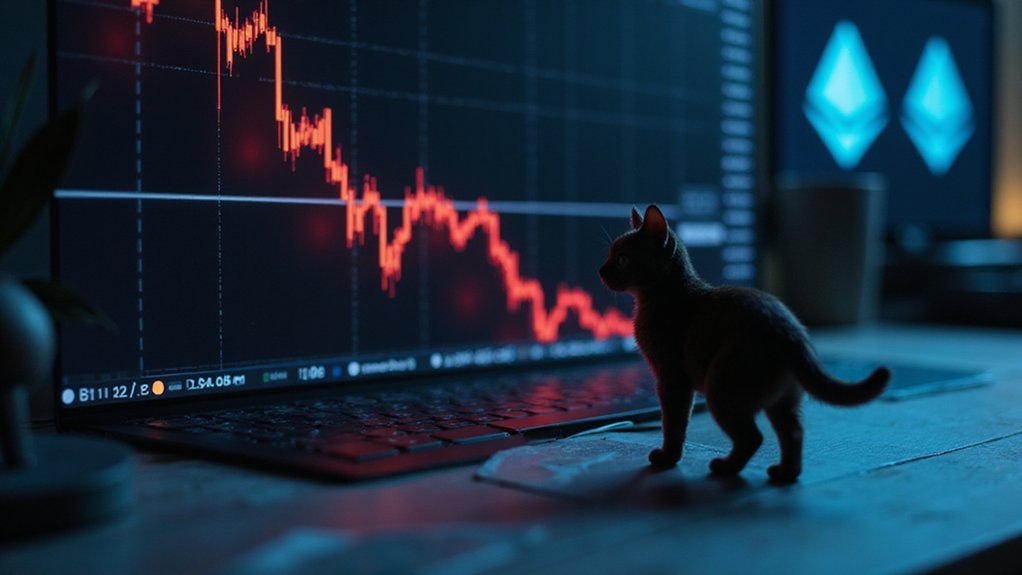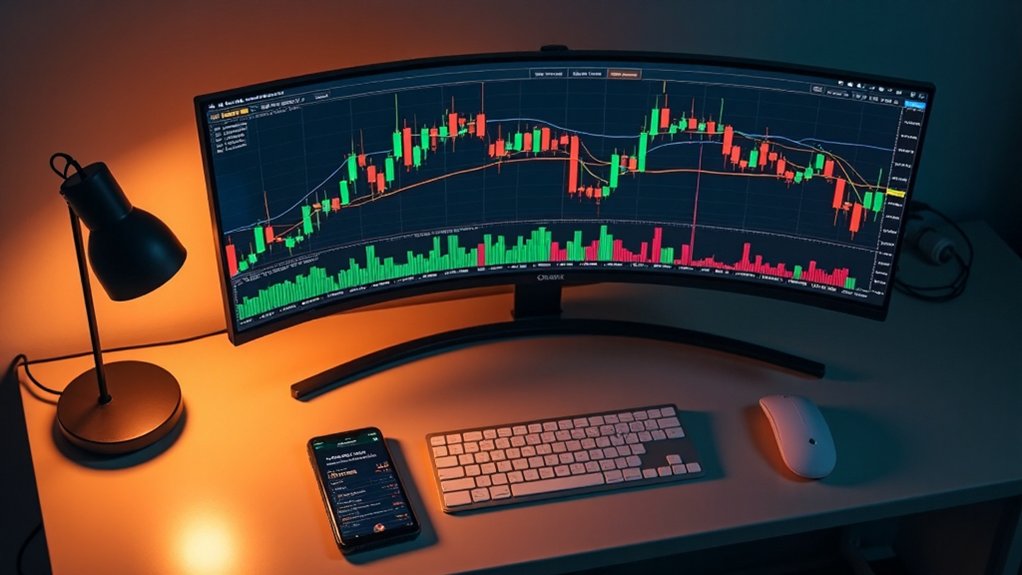Automated Market Makers (AMMs) are blockchain-based protocols that determine cryptocurrency prices through mathematical formulas rather than traditional order books. They leverage liquidity pools—asset pairs contributed by providers who earn fees—to facilitate permissionless trading without requiring counterparties. Using the constant product formula (xy=k), AMMs maintain continuous liquidity regardless of market conditions. This DeFi innovation enables anyone with crypto assets to participate in markets that once required institutional gatekeepers. The machinery beneath this elegant solution reveals even more fascinating implications.

An Automated Market Maker represents one of the more elegant solutions to emerge from the primordial soup of decentralized finance—a mechanism that has fundamentally rewritten the rules of cryptocurrency trading.
Unlike traditional exchanges predicated on order books and matching systems, AMMs employ algorithmic formulas (most particularly the constant product formula) to determine asset prices based on the ratio of tokens within liquidity pools.
This mathematical architecture eliminates the need for counterparties, allowing users to execute trades against these pools rather than waiting for a willing buyer or seller—a quantum leap in market efficiency, if ever there was one.
The operational infrastructure of AMMs hinges on crowdsourced liquidity pools, where providers deposit pairs of assets and receive transaction fees proportional to their contributions.
Liquidity providers constitute the lifeblood of AMMs, earning their rewards while shouldering the machinery of decentralized exchange.
These providers—the unsung heroes of the DeFi ecosystem—effectively replace the market makers of traditional finance, though they subject themselves to the notorious phenomenon of impermanent loss¹.
Smart contracts automate the entire process, executing trades seamlessly and maintaining constant liquidity regardless of market conditions or time of day.
Platforms like Uniswap, SushiSwap, and Curve Finance have demonstrated the robust utility of the AMM model, each with their particular algorithmic nuances and governance structures. AMMs utilize the xy=k equation to maintain a constant product between token reserves during trades.
Their permissionless nature opens financial markets to previously excluded participants, while their decentralized architecture enhances security and transparency (though not without introducing novel vulnerabilities that traditional systems conveniently avoid).
The implications for DeFi extend far beyond mere trading efficiency.
AMMs have catalyzed innovation across the financial landscape, enabling complex instruments like flash loans and yield farming strategies that would be inconceivable in centralized systems.
Despite challenges—slippage remains particularly problematic for large trades, and regulatory ambiguity continues to cast a long shadow—AMMs have incontrovertibly altered the trajectory of financial services.
They represent, perhaps, the first truly native financial primitive of the blockchain era, one that doesn’t merely replicate traditional systems but reimagines them entirely.
These platforms embody the core blockchain philosophy of no central control, allowing anyone with crypto assets to participate without intermediaries or permissions.
Notable implementations like Raydium on Solana combine AMM functionality with central limit orderbooks to achieve even greater liquidity and trading efficiency while maintaining the decentralized ethos.
¹The counterintuitive situation where holding assets separately would have yielded greater returns than providing liquidity.
Frequently Asked Questions
How Do AMMS Handle Impermanent Loss Risks?
AMMs tackle impermanent loss through several strategic approaches.
They implement concentrated liquidity pools with correlated token pairs or stablecoins to reduce price divergence risk.
Some protocols offer compensatory mechanisms—liquidity mining rewards and elevated trading fees—that offset potential losses.
Alternative bonding curve designs modify the constant product formula to minimize rebalancing effects.
More sophisticated AMMs incorporate insurance funds or impermanent loss protection features, effectively subsidizing LPs during unfavorable market conditions (though someone always pays for this protection, naturally).
Can AMMS Be Used for Cross-Chain Token Swaps?
Yes, AMMs can indeed facilitate cross-chain token swaps through specialized protocols like THORChain and SushiSwap.
These systems employ blockchain interoperability solutions to connect disparate networks, enabling users to trade assets across chains without traversing multiple platforms.
While offering enhanced liquidity aggregation and streamlined user experience, cross-chain AMMs aren’t without peril—they introduce additional security vulnerabilities and regulatory complexities that traditional single-chain systems neatly avoid.
Proper implementation requires robust security measures and regular audits.
What Security Vulnerabilities Are Common in AMM Protocols?
AMM protocols face a veritable rogues’ gallery of security threats, including impermanent loss, smart contract vulnerabilities, and oracle manipulation.
Front-running attacks—where transactions are maliciously reordered—remain persistently problematic, while flash loan exploits can devastate liquidity pools in seconds.
Reentrancy vulnerabilities continue plaguing inadequately audited code, and liquidity pool manipulation threatens market integrity.
The cross-chain variants previously discussed introduce additional attack vectors, compounding these risks through interoperability channels that, ironically, expand both utility and vulnerability footprints simultaneously.
How Do AMM Fees Compare to Traditional Exchange Fees?
AMM fees generally present a more egalitarian structure than their traditional counterparts, offering standardized rates (typically 0.01-0.3% per swap) regardless of trader classification.
Traditional exchanges, meanwhile, employ the more stratified maker-taker model—rebating liquidity providers while charging takers premium rates often exceeding 0.5%.
The fee distribution mechanism also differs fundamentally; AMMs automatically allocate proceeds proportionally to LP stake size, whereas traditional venues filter revenues through corporate hierarchies before shareholder distribution.
Can AMMS Support Limit Orders Like Centralized Exchanges?
While traditional AMMs originally lacked limit order functionality (operating on the constant product formula where trades execute at prevailing pool prices), modern iterations have evolved considerably.
Many now integrate with central limit order books or offer hybrid solutions that effectively simulate limit orders through concentrated liquidity positions.
Platforms increasingly support customizable price-bound trades, algorithmic order placement, and cross-chain limit orders—narrowing the once-stark functional divide between decentralized AMMs and their centralized exchange counterparts.









